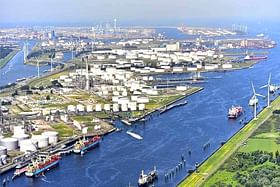The Green Hydrogen Hubs will be planned in a manner that also promotes development in the coastal zones, in the vicinity of such ports.
This will contribute to India’s aim to become Aatmanirbhar through clean energy and serve as an inspiration for the global Clean Energy Transition.
The Ministry of Ports, Shipping, and Waterways (MoPSW) has identified and nominated Paradip Port (Odisha), Deendayal Port (Gujarat), and V O Chidambaranar Port (Tamil Nadu) to be developed as hydrogen hubs.
The ports, as envisioned in the National Green Hydrogen Mission, will be made capable of handling, storage and generation of green hydrogen to meet India’s 2030 hydrogen production goals.
This will contribute to India’s aim to become Aatmanirbhar through clean energy and serve as an inspiration for the global Clean Energy Transition.
Additionally, this will assist India in becoming the world’s hub for the production, use, and sale of green hydrogen and its derivatives.
Union Minister for Ports, Shipping, and Waterways, Sarbananda Sonowal stated that the ministry had already started developing green ports, which will prioritise reducing greenhouse gas emissions to make the Indian maritime industry sustainable.
“The ports have also aimed to reduce Carbon emissions, per tonne of cargo handled, by 30 per cent by the year 2030. The Maritime Vision Document-2030, released by Prime Minister, is a 10-Year blueprint on India’s vision of a sustainable Maritime sector and vibrant blue economy,” said the minister, reports Mint.
The ministry is upgrading major ports with shore-to-ship electricity, and promoting the use and promotion of electrically powered port machinery.
Additionally, it is also constructing storage and bunkering facilities for environmentally friendly fuels such as Hydrogen and Ammonia.
The Green Hydrogen Hubs and associated infrastructure will be planned in a manner that also promotes development in the coastal zones in the vicinity of such ports.
Importance Of Green Hydrogen Hubs
Given the technical and logistical challenges inherent in transporting Hydrogen over long distances, a cluster-based production and utilisation model would enhance the viability of Green Hydrogen projects in the initial years.
This would, in turn, enable economies of scale and convergence of key infrastructure requirements in geographically proximate areas.
National Green Hydrogen Mission
The mission seeks to promote the development of green hydrogen production capacity of at least five MMT (million metric tonnes) per annum with an associated renewable energy capacity addition of about 125 GW in the country by 2030.

The Mission will have wide-ranging benefits — creation of export opportunities for green hydrogen and its derivatives; decarbonisation of industrial, mobility and energy sectors and reduction in dependence on imported fossil fuels and feedstock.
It will also include development of indigenous manufacturing capabilities, creation of employment opportunities, and development of cutting-edge technologies, an official statement said.
The Mission will facilitate demand creation, production, utilisation and export of Green Hydrogen.
Under the Strategic Interventions for Green Hydrogen Transition Programme (SIGHT), two distinct financial incentive mechanisms — targeting domestic manufacturing of electrolysers and production of green hydrogen — will be provided under the Mission.
India’s National Hydrogen Mission is a futuristic vision that can fetch environmental laurels and meet strategic objectives.


